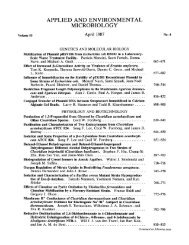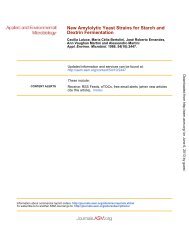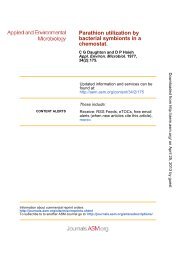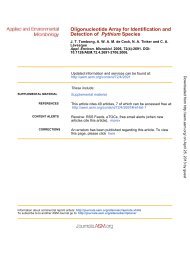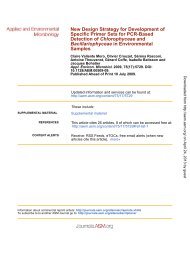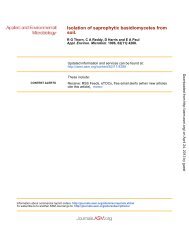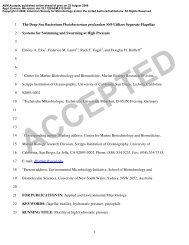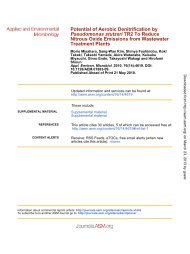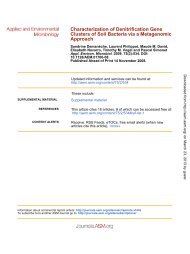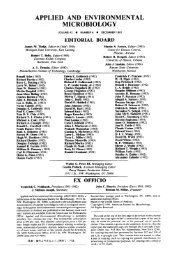Production, Secretion, and Cell Surface Display of Recombinant ...
Production, Secretion, and Cell Surface Display of Recombinant ...
Production, Secretion, and Cell Surface Display of Recombinant ...
Create successful ePaper yourself
Turn your PDF publications into a flip-book with our unique Google optimized e-Paper software.
<strong>Production</strong>, <strong>Secretion</strong>, <strong>and</strong> <strong>Cell</strong> <strong>Surface</strong> <strong>Display</strong> <strong>of</strong> <strong>Recombinant</strong><br />
Sporosarcina ureae S-Layer Fusion Proteins in Bacillus megaterium<br />
Denise Knobloch, Kai Ostermann, <strong>and</strong> Gerhard Rödel<br />
Institute <strong>of</strong> Genetics, Technische Universität Dresden, Dresden, Germany<br />
Monomolecular crystalline bacterial cell surface layers (S-layers) have broad application potential in nanobiotechnology due to<br />
their ability to generate functional supramolecular structures. Here, we report that Bacillus megaterium is an excellent host organism<br />
for the heterologous expression <strong>and</strong> efficient secretion <strong>of</strong> hemagglutinin (HA) epitope-tagged versions <strong>of</strong> the S-layer protein<br />
SslA from Sporosarcina ureae ATCC 13881. Three chimeric proteins were constructed, comprising the precursor,<br />
C-terminally truncated, <strong>and</strong> N- <strong>and</strong> C-terminally truncated forms <strong>of</strong> the S-layer SslA protein tagged with the human influenza<br />
hemagglutinin epitope. For secretion <strong>of</strong> fusion proteins, the open reading frames were cloned into the Escherichia<br />
coli-Bacillus megaterium shuttle vector pHIS1525. After transformation <strong>of</strong> the respective plasmids into Bacillus megaterium<br />
protoplasts, the recombinant genes were successfully expressed <strong>and</strong> the proteins were secreted into the growth medium.<br />
The isolated S-layer proteins are able to assemble in vitro into highly ordered, crystalline, sheetlike structures with<br />
the fused HA tag accessible to antibody. We further show by fluorescent labeling that the secreted S-layer fusion proteins<br />
are also clustered on the cell envelope <strong>of</strong> Bacillus megaterium, indicating that the cell surface can serve in vivo as a nucleation<br />
point for crystallization. Thus, this system can be used as a display system that allows the dense <strong>and</strong> periodic presentation<br />
<strong>of</strong> S-layer proteins or the fused tags.<br />
The cell envelope <strong>of</strong> many bacterial <strong>and</strong> archaeal species is covered<br />
by surface layers (S-layers). Typically, they are composed<br />
<strong>of</strong> a single protein or glycoprotein species that can form crystalline<br />
arrays exhibiting specific lattice symmetries (34). This regular<br />
protein meshwork possesses pores which are well-defined in size<br />
<strong>and</strong> morphology. Most S-layer proteins harbor an N-terminal secretion<br />
signal peptide that allows active transport by the Secdependent<br />
general secretory pathway across the cytoplasmic<br />
membrane (7). In Gram-positive bacteria, the S-layers are associated<br />
with a heteropolysaccharide called secondary cell wall polymer<br />
(SCWP) (30, 35). The N-terminal parts <strong>of</strong> many S-layer proteins<br />
possess highly conserved amino acid sequences, the so-called<br />
S-layer homology (SLH) domains, that mediate attachment to the<br />
pyruvylated negatively charged SCWPs. Another binding mechanism<br />
<strong>of</strong> S-layer proteins involves a highly conserved N-terminal<br />
region comprising neither SLH domains nor SCWPs that consists<br />
<strong>of</strong> N-acetylglucosamine, glucose, <strong>and</strong> 2,3-dideoxydiacetamido<br />
mannosamine uronic acid (12, 20). The structural integrity <strong>of</strong><br />
S-layers <strong>and</strong> their adhesion to the underlying cell envelope component<br />
are based on noncovalent forces (38). The interaction can<br />
be disrupted by high concentrations <strong>of</strong> chaotropic or metalchelating<br />
agents (34). Upon the removal <strong>of</strong> the respective agent,<br />
the S-layer subunits recrystallize into regular arrays in suspension<br />
or on surfaces.<br />
Due to these unique features, S-layers have broad application<br />
potentials in biotechnology, nanotechnology, <strong>and</strong> biomimetics.<br />
To date, recombinant S-layer proteins have been generated in<br />
Escherichia coli (15, 19, 25, 32), Bacillus subtilis (18, 41), Lactobacillus<br />
lactis (27), Lactobacillus casei (3), Lactobacillus brevis (1),<br />
Caulobacter crescentus (5, 26), Saccharomyces cerevisiae, <strong>and</strong> HeLa<br />
cells (6, 21).<br />
In the case <strong>of</strong> some S-layer proteins, it was reported that the<br />
cloned genes were not stable when expressed in E. coli or that<br />
expression resulted in nonviability <strong>of</strong> E. coli transformants. Such<br />
observations were made for the S-layer proteins <strong>of</strong> Aeromonas<br />
salmonicida (9), B. brevis 47 (46), <strong>and</strong> L. brevis (43). The instability<br />
may be explained by direct repeats within the gene which may<br />
facilitate recombination or error-prone replication (9).<br />
Here, we report on the expression <strong>of</strong> functional hemagglutinin<br />
(HA) epitope-tagged SslA derivatives <strong>of</strong> the Sporosarcina ureae<br />
ATCC 13881 S-layer in the Gram-positive Bacillus megaterium.It<br />
is commonly accepted that B. megaterium possesses S-layers in its<br />
natural environment (4, 37). Due to long term-cultivation, the<br />
laboratory strain that we use for expression lost this ability<br />
(MoBiTec, personal communication). The B. megaterium expression<br />
system may <strong>of</strong>fer an alternative for the heterologous production<br />
<strong>of</strong> S-layer proteins due to several advantages over other<br />
expression systems. These include a lack <strong>of</strong> alkaline protease activities,<br />
efficient secretion <strong>of</strong> heterologous proteins into the medium,<br />
structural <strong>and</strong> segregational stability <strong>of</strong> recombinant plasmids,<br />
<strong>and</strong> the use <strong>of</strong> inexpensive substrates (42). Cloning into the<br />
E. coli-B. megaterium shuttle vector pHIS1525 allows the translational<br />
fusion <strong>of</strong> the target proteins with the secretion peptide <strong>of</strong><br />
the extracellular esterase LipA (SP lipA), resulting in secretion <strong>of</strong> the<br />
respective proteins.<br />
MATERIALS AND METHODS<br />
Bacterial strains <strong>and</strong> culture conditions. Sporosarcina ureae ATCC<br />
13881 cells (Max-Planck Institute for Biochemistry, Martinsried, Germany)<br />
were grown at 30°C in LB medium (1% peptone, 0.5% yeast extract,<br />
0.5% NaCl). E. coli Top10 [F � mcrA �(mrr-hsdRMS-mcrBC)<br />
Received 13 July 2011 Accepted 2 November 2011<br />
Published ahead <strong>of</strong> print 18 November 2011<br />
Address correspondence to Denise Knobloch, Denise.Knobloch@web.de.<br />
Supplemental material for this article may be found at http://aem.asm.org/.<br />
Copyright © 2012, American Society for Microbiology. All Rights Reserved.<br />
doi:10.1128/AEM.06127-11<br />
560 aem.asm.org 0099-2240/12/$12.00 Applied <strong>and</strong> Environmental Microbiology p. 560–567
FIG 1 Scheme <strong>of</strong> constructed chimeric genes. The chimeric genes encoding the precursor, the C-terminally truncated, <strong>and</strong> the N- <strong>and</strong> C-terminally truncated<br />
forms <strong>of</strong> the S-layer protein SslA from Sporosarcina ureae ATCC 13881 <strong>and</strong> three copies <strong>of</strong> the epitope <strong>of</strong> the hemagglutinin protein (HA) were fused via two<br />
protease recognition sites (thrombin [thr] <strong>and</strong> factor Xa) <strong>and</strong> a (Gly) 4Ser linker. Cloning in the E. coli-B. megaterium shuttle vector pHIS1525 allows translational<br />
fusion with the secretion peptide <strong>of</strong> the extracellular esterase LipA (SP lipA). Intracellular accumulation <strong>of</strong> recombinant proteins is achieved by cloning <strong>of</strong> the<br />
respective reading frames in the E. coli-B. megaterium shuttle vector pHIS1522.<br />
�80lacZ�M15 �lacC74 recA1 araD139 �(ara-leu)7697 galU galK rpsL<br />
(Str r ) endA1 nupG] (Invitrogen, United States) was used for cloning <strong>of</strong><br />
target genes. The E. coli strain was grown at 37°C in LB medium (pH 7.4)<br />
with 1.5% agar for plates containing 100 �g/ml ampicillin to select for<br />
plasmid-bearing cells. B. megaterium WH320 <strong>and</strong> MS941 (MoBiTec<br />
GmbH, Germany) were used for recombinant expression <strong>of</strong> three S-layer<br />
variants <strong>of</strong> S. ureae ATCC 13881 S-layer SslA. B. megaterium cells were<br />
cultured at 37°C in enriched LB medium (1% peptone, 0.5% yeast extract,<br />
1% NaCl, pH 7.5) with 1.5% agar for plates supplemented with 10 �g/ml<br />
tetracycline.<br />
Constructs <strong>and</strong> cloning. Cloning <strong>of</strong> the S-layer fusion proteins (Fig.<br />
1) was performed in two steps. Gene sequences encoding the full-length<br />
(amino acids [aa] 1 to 1099) recombinant SslA protein [rSslA (aa1-1099)]<br />
<strong>and</strong> its truncated variants rSslA (aa32-928) <strong>and</strong> rSslA (aa341-928) were PCR<br />
amplified from S. ureae ATCC 13881 chromosomal DNA using primers<br />
listed in Table 1. The restriction sites for NarI <strong>and</strong> SphI were introduced<br />
via PCR at the 5= <strong>and</strong> 3= ends, respectively. The purified PCR fragments, as<br />
well as the vector pHIS1525 (MoBiTec GmbH, Germany) containing the<br />
strong xylA promoter <strong>of</strong> B. megaterium, were digested with the restriction<br />
endonucleases NarI <strong>and</strong> SphI <strong>and</strong> cloned in frame to the lipase A secretion<br />
peptide present in the vector. For the production <strong>of</strong> proteins lacking a<br />
secretion signal, the gene sequence encoding the N- <strong>and</strong> C-terminally<br />
truncated variant iSslA (aa341-928), lacking a secretion signal (<strong>and</strong> therefore<br />
TABLE 1 Oligonucleotide primers<br />
Primer, direction, <strong>and</strong> sequence (5= to 3=) a<br />
<strong>Surface</strong> <strong>Display</strong> <strong>of</strong> Secreted S-Layer Fusion Proteins<br />
accumulating in the host cell), was cloned into the vector pHIS1522 (Mo-<br />
BiTec GmbH, Germany). PCR using primers listed in Table 1 introduced<br />
the restriction sites for KpnI <strong>and</strong> SphI at the 5= <strong>and</strong> 3= ends. After ligation,<br />
the plasmids were established in E. coli TOP10. The gene sequence encoding<br />
an HA tag was amplified by PCR (primers listed in Table 1), inserting<br />
the restriction site for SphI at the 5= end <strong>and</strong> for AgeI at the 3= end,<br />
respectively. PCR fragments, as well as pHIS1525 <strong>and</strong> pHIS1522 carrying<br />
the coding sequences for the SslA variants, were digested with the restriction<br />
enzymes SphI <strong>and</strong> AgeI. After ligation, pHIS1525 <strong>and</strong> pHIS1522 carrying<br />
the recombinant constructs were established in E. coli TOP10.<br />
Expression <strong>of</strong> recombinant S-layers. The transformation <strong>of</strong> B. megaterium<br />
protoplasts was performed according to the manufacturer’s instructions<br />
(MoBiTec). The transformed B. megaterium colonies were<br />
picked <strong>and</strong> grown overnight in LB medium containing tetracycline. Overnight<br />
cultures were diluted in LB medium supplemented with tetracycline<br />
to an optical density at 600 nm (OD 600)<strong>of</strong>�0.4. For induction <strong>of</strong> protein<br />
expression, 0.5% (wt/vol) xylose was added. Bacteria were harvested by<br />
centrifugation 7 h <strong>and</strong> 24 h following induction. The culture supernatant<br />
was also collected.<br />
Immunolabeling <strong>of</strong> self-assembly products. For investigation <strong>of</strong> the<br />
accessibility <strong>of</strong> the HA tag at the C terminus <strong>of</strong> the S-layer fusion protein,<br />
self-assembly products formed on transmission electron microscopy<br />
(TEM) grids were incubated with ZnO-labeled anti-HA antibodies<br />
PCR fragment No. Forward No. Reverse<br />
rSslA (aa1-1099) 1 TAT TAT GGC GCC GCT AAC CAA CCA 5 TAT TAT GCA TGC CCG GAT CCA CGC<br />
ACG AAA TA<br />
GGA ACC AGT TTA GAA GTT ACT TTT<br />
ATA ACA GG<br />
rSslA (aa32-928) 2 TAT TAT GGC GCC GCT GAA TTC ACA 6 TAT TAT GCA TGC CCG GAT CCA CGC<br />
GAT GTA AAA GAC<br />
GGA ACC AGC GAA CTA ATA ACT AAT<br />
GCA TTT GC<br />
rSslA (aa341-928) 3 TAT TAT GGC GCC ACT GGC GTT AAA 6 TAT TAT GCA TGC CCG GAT CCA CGC<br />
AAA GCA GGA AT<br />
GGA ACC AGC GAA CTA ATA ACT AAT<br />
GCA TTT GC<br />
iSslA (aa341-928) 4 TAT TAT GGT ACC GGA TGA CTG 6 TAT TAT GCA TGC CCG GAT CCA CGC<br />
GCG TTA AAA AAG CAG GAA T<br />
GGA ACC AGC GAA CTA ATA ACT AAT<br />
GCA TTT GC<br />
HA tag 7 TAT ATA GCA TGC CAT CGA AGG TCG 8 TAT TAT ACC GGT CTA TTA GCG GCC GCA<br />
TGG CGG C<br />
CTG AGC AG<br />
a Cloning sites are underlined (NarI/KpnI at the 5= end <strong>and</strong> SphI at the 3= end <strong>of</strong> the coding sequence for S-layer derivatives <strong>and</strong> SphI at the 5= end <strong>and</strong> AgeI at the 3= end <strong>of</strong> the<br />
coding sequence for the hemagglutinin tag). Primer sequences were derived from the corrected sslA sequence (GenBank accession no. AM085153).<br />
Cloning<br />
site<br />
NarI SphI<br />
NarI SphI<br />
NarI SphI<br />
KpnI SphI<br />
SphI AgeI<br />
January 2012 Volume 78 Number 2 aem.asm.org 561
Knobloch et al.<br />
(0.04% ZnO with 32 �g/ml anti-HA antibodies in phosphate-buffered<br />
saline [PBS]; Roche) for1hat20°C. Subsequently, unbound ZnO-labeled<br />
antibody was removed by placing TEM grids on a drop <strong>of</strong> water. After<br />
drying, samples were subjected to TEM analysis. As a control, the same<br />
procedure was carried out with authentic SslA.<br />
For the dot blot assay, in vitro-assembled fusion proteins were centrifuged<br />
<strong>and</strong> the pellet was washed twice to remove monomeric proteins.<br />
After resuspension <strong>of</strong> the pellet, the assembled fusion proteins were dried<br />
on a polyvinylidene difluoride (PVDF) membrane (Millipore) <strong>and</strong> incubated<br />
with monoclonal anti-HA antibodies (Roche). Detection <strong>of</strong> bound antibodies<br />
was performed with horseradish peroxidase (HRP)-conjugated secondary<br />
antibodies (Amersham Bioscience) <strong>and</strong> the ECL Plus kit (Amersham Pharmacia<br />
Biotech).<br />
Electron microscopy. S-layer-producing B. megaterium cells were incubated<br />
with 2 M guanidine hydrochloride (Gua-HCl) to remove the<br />
secreted <strong>and</strong> assembled S-layers from the cell envelope. After dialysis against<br />
dH 2O for 24 h at 4°C, the assembled S-layers were applied to carbon-coated<br />
copper grids for electron microscopy. The preparations were examined with a<br />
Morgagni 268 electron microscope operated at 80 kV.<br />
Microscopy. For light <strong>and</strong> fluorescence microscopy, B. megaterium<br />
cells expressing S-layer fusion constructs were harvested at different time<br />
points, washed with PBS, <strong>and</strong> adjusted to an OD 600 <strong>of</strong> 1. The cells were<br />
treated with 100 �g/ml bovine serum albumin (BSA) in PBS <strong>and</strong> incubated<br />
for 1 h with anti-hemagglutinin-Alexa Fluor 488 conjugates (Invitrogen).<br />
After washing with PBS, samples were analyzed in a fluorescence<br />
microscope (Keyence, Neu-Isenburg, Germany).<br />
Protein analysis. Overnight cultures were harvested <strong>and</strong> shifted into<br />
fresh medium containing 0.5% xylose to induce the expression <strong>of</strong> various<br />
SslA constructs. Samples were taken before induction <strong>and</strong> at 7 h <strong>and</strong> 24 h<br />
after induction. <strong>Cell</strong>s were washed three times with PBS, <strong>and</strong> 1 � 10 9 cells<br />
were incubated with 2 M Gua-HCl for1hatroom temperature. Secreted<br />
proteins from the growth medium, as well as proteins extracted with Gua-<br />
HCl, were precipitated using the methanol-chlor<strong>of</strong>orm method (44). Precipitated<br />
proteins were dissolved in Laemmli buffer, separated by SDS-<br />
PAGE (22), <strong>and</strong> blotted onto PVDF membrane (Millipore). As a control,<br />
50 �g <strong>of</strong> whole-cell lysate was analyzed.<br />
For Western blot analysis, HA-specific monoclonal antibodies<br />
(Roche) <strong>and</strong> HRP-conjugated anti-mouse IgG (Amersham Bioscience)<br />
were used as primary <strong>and</strong> secondary antibodies, respectively. Detection <strong>of</strong><br />
bound antibodies was performed by an enhanced chemiluminescence assay<br />
(ECL; Amersham Bioscience).<br />
RESULTS<br />
Expression <strong>of</strong> the genes encoding the three S-layer fusion proteins<br />
rSslA (aa1-1099)-HA, rSslA (aa32-928)-HA, <strong>and</strong> rSslA (aa341-928)-<br />
HA. The heterologous expression <strong>of</strong> genes encoding three different<br />
S-layer fusion proteins (Fig. 1) in B. megaterium was<br />
investigated. SslA <strong>of</strong> S. ureae ATCC 13881 possesses an N-terminal<br />
secretion signal <strong>of</strong> 31 amino acids. It was shown that the N-terminal<br />
340 amino acids <strong>and</strong> the C-terminal 171 amino acids can be deleted<br />
without interfering with the self-assembly process (32). Three fusion<br />
proteins consisting <strong>of</strong> the full-length [rSslA (aa1-1099)], the<br />
C-terminally truncated [rSslA (aa32-928)], <strong>and</strong> the N- <strong>and</strong> C-terminally<br />
truncated [rSslA (aa341-928)] SslA protein <strong>and</strong> the fused hemagglutinin<br />
(HA) epitope tag were constructed (see Materials <strong>and</strong> Methods; also<br />
see Fig. S1 to S3 in the supplemental material). The S-layer fusion<br />
constructs were cloned into the E. coli-B. megaterium shuttle vector<br />
pHIS1525. This vector includes, in addition to the strong xylA<br />
promoter <strong>of</strong> B. megaterium, the signal peptide sequence <strong>of</strong> the<br />
extracellular esterase LipA (SP lipA), which allows the secretion <strong>of</strong><br />
the recombinant proteins into the culture broth (31).<br />
After the induction <strong>of</strong> expression by the addition <strong>of</strong> xylose, cells<br />
were harvested at various time points <strong>and</strong> subjected to SDS-PAGE<br />
analysis. Both the whole-cell lysates <strong>and</strong> concentrated growth medium<br />
from B. megaterium WH320 cultures with plasmids encoding<br />
the constructs rSslA (aa1-1099)-HA, rSslA (aa32-928)-HA, <strong>and</strong><br />
rSslA (aa341-928)-HA showed additional high-molecular-mass protein<br />
b<strong>and</strong>s on SDS gels in comparison to the results for noninduced<br />
B. megaterium cells (Fig. 2). The apparent molecular masses<br />
<strong>of</strong> 130 kDa, 110 kDa, <strong>and</strong> 70 kDa <strong>of</strong> these protein b<strong>and</strong>s correspond<br />
well with the theoretical molecular masses estimated for the<br />
three fusion proteins. Obviously, all three S-layer fusion proteins<br />
are efficiently expressed in B. megaterium <strong>and</strong> secreted into growth<br />
medium. A number <strong>of</strong> low-molecular-mass protein b<strong>and</strong>s possibly<br />
representing degradation products were also observed. Western<br />
blot analysis using specific antibodies against the HA tag identified<br />
the chimeric proteins in B. megaterium cell lysate <strong>and</strong> in the<br />
culture supernatant. Only the supernatant fraction showed lowmolecular-mass<br />
protein b<strong>and</strong>s (Fig. 2B), indicating that protein<br />
degradation is preferentially mediated by extracellular proteases.<br />
In order to test whether the major extracellular protease NprM<br />
(45) is responsible for the observed degradation, the S-layer fusion<br />
constructs were expressed in the NprM-deficient B. megaterium<br />
strain MS941. However, the degradation pattern <strong>of</strong> the secreted<br />
proteins was unchanged (see Fig. S4 in the supplemental material),<br />
indicating that the proteolytic activity is due to another extracellular<br />
protease(s).<br />
Localization <strong>of</strong> recombinant S-layer proteins in B. megaterium<br />
cells. It was discussed that B. megaterium cells carry S-layer<br />
proteins in their natural environment (4, 37), but long-term cultivation<br />
<strong>of</strong> expression strains under laboratory conditions can lead<br />
to the loss <strong>of</strong> this property. We were interested in whether the<br />
outer surface <strong>of</strong> such host cells may provide nucleation points<br />
for the assembly <strong>of</strong> secreted recombinant S-layer fusion proteins.<br />
Transformed B. megaterium cells were harvested 7 h after induction,<br />
washed to remove proteins from the culture medium, <strong>and</strong><br />
treated with 2 M guanidine hydrochloride (Gua-HCl). The chaotropic<br />
agent is able to remove noncovalently associated proteins<br />
like S-layers from the cell wall. Incubation with low concentrations<br />
<strong>of</strong> chaotropic agents maintains cell integrity, whereas higher<br />
concentrations (5 M Gua-HCl) lead to cell damage (data not<br />
shown). Western blot analysis <strong>of</strong> extracted proteins with anti-HA<br />
antibody showed a strong signal at the expected molecular mass <strong>of</strong><br />
the fusion proteins, indicating that the recombinant S-layer fusion<br />
proteins were located on the cell surface <strong>of</strong> B. megaterium. Fluorescence<br />
microscopy <strong>of</strong> whole cells that were harvested 7 h after<br />
induction <strong>and</strong> incubated for 1 h with Alexa Fluor dye-labeled<br />
mouse anti-HA antibodies revealed a homogeneous distribution<br />
<strong>of</strong> green fluorescence around B. megaterium cells expressing<br />
the full-length S-layer fusion construct rSslA (aa1-1099)-HA<br />
(Fig. 3E), while the expression <strong>of</strong> the C-terminally truncated<br />
form rSslA (aa32-928)-HA led to spotlike structures surrounding<br />
the whole cell (Fig. 3F). These fluorescent dots are mainly<br />
found at the cell poles <strong>and</strong> at regions <strong>of</strong> septum formation. The<br />
expression <strong>of</strong> the N- <strong>and</strong> C-terminally truncated form<br />
rSslA (aa341-928)-HA resulted in a weak fluorescent signal surrounding<br />
the cells (Fig. 3G). B. megaterium cells that expressed<br />
the N- <strong>and</strong> C-terminally truncated S-layer fusion protein<br />
iSslA (aa341-928)-HA that lacks the secretion signal were used as a<br />
control. These cells did not exhibit any fluorescence after treatment<br />
with Alexa Fluor-labeled mouse anti-HA antibodies. To<br />
analyze whether a concentration <strong>of</strong> 2 M Gua-HCl is sufficient<br />
to remove S-layer proteins from the cell surface completely, the<br />
562 aem.asm.org Applied <strong>and</strong> Environmental Microbiology
cells were treated with the respective concentration <strong>and</strong> washed<br />
twice with PBS. After incubation with Alexa Fluor-labeled<br />
mouse anti-HA antibodies <strong>and</strong> fluorescence microscopic analysis,<br />
cells still exhibited fluorescence, indicating that 2 M Gua-<br />
HCl is not sufficient to completely remove S-layer proteins<br />
associated with the cell wall (data not shown).<br />
Isolation <strong>and</strong> formation <strong>of</strong> self-assembly products by<br />
rSslA (aa1-1099)-HA <strong>and</strong> the truncated variants. As concluded<br />
from our Western blot analysis <strong>and</strong> fluorescence microscopy data,<br />
the secreted recombinant S-layer fusion proteins were partially<br />
bound on the cell surface <strong>of</strong> B. megaterium. To investigate whether<br />
the chimeric proteins are able to self-assemble in vitro, the proteins<br />
were extracted from the cell wall with 2 M Gua-HCl <strong>and</strong><br />
dialyzed against distilled water (dH 2O). Wild-type B. megaterium<br />
cells were incubated in the respective S-layer monomercontaining<br />
solution for 2 h. Then, the cells were washed two times<br />
with PBS. Treatment with Alexa Fluor-labeled mouse anti-HA<br />
antibody <strong>and</strong> subsequent fluorescence microscopy revealed<br />
that the B. megaterium cells were covered with S-layer fusion<br />
proteins. In the case <strong>of</strong> the full-length S-layer fusion protein<br />
<strong>and</strong> the C-terminally truncated form, a homogeneous distribu-<br />
<strong>Surface</strong> <strong>Display</strong> <strong>of</strong> Secreted S-Layer Fusion Proteins<br />
FIG 2 Expression <strong>and</strong> secretion <strong>of</strong> recombinant S-layer fusion proteins in B. megaterium. Before the addition <strong>of</strong> 0.5% xylose for the induction <strong>of</strong> protein<br />
expression, transformed B. megaterium WH320 cells were grown until the OD 600 reached �0.4. Samples were taken at 0, 7, <strong>and</strong> 24 h after induction. (A) An<br />
amount <strong>of</strong> 50 �g <strong>of</strong> whole-cell lysate <strong>and</strong> proteins from 300 �l <strong>of</strong> cell-free growth medium were precipitated, analyzed by SDS-PAGE, <strong>and</strong> stained with Coomassie<br />
brilliant blue R250. (B) For Western blot analysis with anti-HA antibody, Gua-HCl extracts <strong>of</strong> whole B. megaterium cells were prepared as described in Materials<br />
<strong>and</strong> Methods. The respective proteins are indicated by asterisks. Lane M shows prestained protein plus ladder (Fermentas GmbH, Germany).<br />
tion <strong>of</strong> green fluorescence could be observed (Fig. 4). In contrast,<br />
incubation with the N- <strong>and</strong> C-terminally truncated form<br />
rSslA (aa341-928)-HA did not result in fluorescent staining <strong>of</strong> the<br />
cell envelope (Fig. 4G).<br />
An aliquot <strong>of</strong> isolated S-layer fusion proteins (see Materials<br />
<strong>and</strong> Methods) was used for TEM analysis. Unstained assemblies <strong>of</strong><br />
S-layer variants revealed flat double <strong>and</strong> multilayer sheets (Fig. 5).<br />
The size <strong>of</strong> multilayer structures formed in suspension was between<br />
0.1 <strong>and</strong> 0.5 �m 2 . In line with multilayer structures, we occasionally<br />
observed moiré patterns, as shown in Fig. 5B, for the<br />
C-terminally truncated S-layer fusion protein.<br />
Investigation <strong>of</strong> accessibility <strong>of</strong> the fused HA tag. The accessibility<br />
<strong>and</strong> functionality <strong>of</strong> the fused hemagglutinin tag <strong>of</strong> recrystallized<br />
S-layer fusion proteins was first tested in dot blot assays.<br />
All three fusion proteins yielded a strong signal with the anti-HA<br />
antibody (Fig. 6). This result indicates the accessibility <strong>of</strong> the fused<br />
HA tag for the respective antibodies. Native SslA that was used as<br />
a control showed no reaction with the antibody. The functionality<br />
<strong>of</strong> the fused peptide was further investigated by labeling with<br />
anti-HA ZnO conjugates. As shown in Fig. 7A to C, self-assembly<br />
products <strong>of</strong> all three S-layer fusion proteins were densely la-<br />
January 2012 Volume 78 Number 2 aem.asm.org 563
Knobloch et al.<br />
FIG 3 Optical (A, B, C, D) <strong>and</strong> fluorescent (E, F, G, H) images <strong>of</strong> B. megaterium cells expressing S-layer fusion proteins. B. megaterium cells expressing <strong>and</strong><br />
secreting rSslA (aa1-1099)-HA (A, E), rSslA (aa32-928)-HA (B, F), or rSslA (aa341-928)-HA (C, G) were cultivated in LB medium <strong>and</strong> harvested 7 h after induction with<br />
xylose, washed with PBS, <strong>and</strong> blocked with BSA. The cells were incubated with anti-hemagglutinin-Alexa Fluor 488 conjugates (Invitrogen) for 1 h <strong>and</strong> analyzed<br />
by fluorescence microscopy. As a control, intracellular iSslA (aa341-928)-HA (D, H) was prepared in the same manner.<br />
beled with the colloidal ZnO conjugates. Diffraction spots obtained<br />
by fast Fourier transform analysis (Fig. 7B, inset) revealed<br />
that the observed ordered structure corresponds to the<br />
lattice spacing <strong>of</strong> 13.2 nm <strong>of</strong> the native SslA (32). Self-assembly<br />
products formed by authentic SslA remained nearly completely<br />
unlabeled (Fig. 7D).<br />
DISCUSSION<br />
S-layer proteins <strong>and</strong> their genetically engineered derivatives have<br />
broad potential for biotechnological applications (17, 28, 33, 36,<br />
39, 40). As outlined in the introduction, different prokaryotic expression<br />
systems, e.g., E. coli, B. subtilis, <strong>and</strong> L. casei, as well as the<br />
eukaryotic model organisms S. cerevisiae <strong>and</strong> HeLa cells, have<br />
been used for heterologous expression <strong>of</strong> S-layer proteins. However,<br />
structural instabilities <strong>and</strong> low levels <strong>of</strong> synthesis affect the<br />
yields <strong>of</strong> these gene expression systems. Here, we report on the<br />
high-level expression <strong>and</strong> secretion <strong>of</strong> functional S-layer derivatives<br />
in the Gram-positive bacterium B. megaterium.<br />
Upon induction <strong>of</strong> the xylA promoter by the addition <strong>of</strong> xylose,<br />
the proteins were efficiently produced <strong>and</strong> secreted into the<br />
growth medium. Low or no proteolytic activity could be observed<br />
for intracellular S-layer fusion proteins. However, the expression<br />
<strong>of</strong> sslA fusion constructs in other expression systems, e.g., S. cerevisiae,<br />
leads to protein degradation (personal communication, N.<br />
Korkmaz). In the case <strong>of</strong> B. megaterium, comparison <strong>of</strong> the cellassociated<br />
<strong>and</strong> the secreted fusion proteins shows significantly<br />
FIG 4 Optical (A, B, C, D) <strong>and</strong> fluorescent (E, F, G, H) images <strong>of</strong> reassembled S-layer fusion proteins on B. megaterium cells. B. megaterium cells were<br />
resuspended in monomer containing S-layer fusion protein solutions <strong>of</strong> rSslA (aa1-1099)-HA (A, E), rSslA (aa32-928)-HA (B, F), or rSslA (aa341-928)-HA (C, G). After<br />
2 h <strong>of</strong> incubation, the cells were harvested <strong>and</strong> washed twice with PBS. For detection <strong>of</strong> assembled S-layer fusion proteins on the surface, cells were incubated with<br />
anti-hemagglutinin-Alexa Fluor 488 conjugates (Invitrogen) for 1 h <strong>and</strong> analyzed by fluorescence microscopy. As a control, wild-type B. megaterium cells (D, H)<br />
were prepared in the same manner.<br />
564 aem.asm.org Applied <strong>and</strong> Environmental Microbiology
FIG 5 TEM analysis <strong>of</strong> recrystallized recombinant S-layer fusion proteins. <strong>Recombinant</strong> rSslA (aa1-1099)-HA (A), rSslA (aa32-928)-HA (B), <strong>and</strong> rSslA (aa341-928)-HA<br />
(C) were isolated with 2 M Gua-HCl from the cell surface <strong>of</strong> B. megaterium transformants. After dialysis against dH 2O, the assembled structures were subjected<br />
to TEM analysis.<br />
more degradation products in the latter fraction. The use <strong>of</strong> the<br />
NprM protease-deficient strain B. megaterium MS941 did not affect<br />
the degradation <strong>of</strong> secreted S-layer fusion proteins. Alternative<br />
explanations for the presence <strong>of</strong> N-terminally truncated fusion<br />
proteins, such as the presence <strong>of</strong> reading frame internal<br />
translation start sites, can be ruled out. Probably, the presence <strong>of</strong><br />
an unknown extracellular protease(s) may explain the observed<br />
degradation <strong>of</strong> secreted proteins.<br />
As described for several truncated versions <strong>of</strong> SslA (32), the<br />
isolated S-layer fusion proteins were able to form highly ordered,<br />
crystalline sheetlike structures in vitro. Due to the structure size<br />
<strong>and</strong> the formation <strong>of</strong> multilayers, no reliable Fourier transformation<br />
analysis could be performed. The moiré pattern observed in<br />
TEM images <strong>of</strong> rSslA (aa32-928)-HA (Fig. 5B), however, points to the<br />
formation <strong>of</strong> highly ordered, crystalline structures. The observation<br />
that the anti-HA antibody binds to monolayers formed by the<br />
S-layer fusion proteins on solid supports (Fig. 7) indicates that the<br />
C-terminal HA tag is exposed to the ambient environment, <strong>and</strong><br />
Fourier transformation analysis revealed the formation <strong>of</strong> lattices<br />
with lattice spacing corresponding to that <strong>of</strong> native SslA <strong>of</strong> 13.2<br />
nm (32). The results obtained by immunolabeling <strong>of</strong> selfassembly<br />
products are in good agreement with studies on various<br />
S-layer fusion proteins that exhibit C-terminally fused functional<br />
domains (e.g., streptavidin [2, 25], birch pollen allergen [8, 15,<br />
18], camel antibody [29], single amino acids [2], <strong>and</strong> enhanced<br />
green fluorescent protein [eGFP] [16]). Studies on structurefunction<br />
relationships revealed that the middle <strong>and</strong>, in some cases,<br />
the C-terminal parts <strong>of</strong> S-layer proteins are responsible for selfassembly<br />
into 2-dimensional protein arrays. The insertion <strong>of</strong><br />
FIG 6 Dot blot assay <strong>of</strong> self-assembly products <strong>of</strong> S-layer fusion proteins <strong>and</strong><br />
authentic (auth.) SslA. Isolated <strong>and</strong> dialyzed recombinant S-layer fusion proteins<br />
showed strong signals in immunological detection using a monoclonal<br />
anti-HA antibody. Authentic SslA that was used as a control showed no reaction<br />
with the antibody.<br />
<strong>Surface</strong> <strong>Display</strong> <strong>of</strong> Secreted S-Layer Fusion Proteins<br />
functional peptide sequences or single amino acids had no or only<br />
slight effects on the formation <strong>of</strong> S-layer sheets. In Gram-positive<br />
bacteria, the N-terminal parts <strong>of</strong> the S-layer proteins, comprising<br />
the SLH domain, are involved in the attachment to the underlying<br />
cell wall. Recent studies revealed that SslA contains three<br />
N-terminal SLH domains (see Fig. S5 in the supplemental material)<br />
(11). In the present study, we could demonstrate that the B.<br />
megaterium cell wall, which is believed to be covered by S-layers in<br />
its natural environment, can serve as a substrate for S-layer assembly.<br />
As shown by fluorescence microscopy <strong>of</strong> immunolabeled B.<br />
megaterium cells, coverage with fluorescent proteins is not homogenous.<br />
There are two possible explanations for this observation:<br />
either the HA tag <strong>of</strong> a subpopulation <strong>of</strong> S-layer fusion proteins<br />
is not accessible for the antibodies or the cell wall is only<br />
partially covered by S-layers. In Gram-positive bacteria, the anchoring<br />
<strong>of</strong> S-layer subunits to the underlying rigid cell envelope<br />
layer occurs by binding to secondary cell wall polymers (SCWPs)<br />
(30, 35). This binding can involve SLH domains <strong>and</strong> pyruvylated<br />
SCWPs or occurs via carbohydrate binding <strong>of</strong> serine, tyrosine,<br />
<strong>and</strong> arginine residues in the N-terminal part <strong>of</strong> S-layer<br />
proteins to an SCWP that contains N-acetylglucosamine <strong>and</strong><br />
N-acetylmannosamine (30). SPR measurements showed that<br />
binding between SLH domains <strong>and</strong> pyruvylated SCWPs is highly<br />
specific (14, 23, 24), <strong>and</strong> therefore, interactions between amino<br />
acids containing hydroxyl, amide, <strong>and</strong> amino groups <strong>and</strong> the<br />
SCWPs were supposed. While the contents <strong>of</strong> amino acid residues<br />
predicted to form hydrogen bonds or dipole-dipole interactions<br />
are nearly the same in the N-terminal <strong>and</strong> middle part <strong>of</strong> the<br />
S-layer protein, there are marked differences in secondary structure.<br />
The central part <strong>of</strong> the SslA fusion protein is characterized by<br />
�-sheet structures, whereas the N-terminal part, mostly arranged<br />
in the SLH <strong>and</strong> signal peptide sequences, is predicted to possess a<br />
high content <strong>of</strong> serine-rich �-helices (see Fig. S5 in the supplemental<br />
material) (10, 13). Possibly, the more homogeneous distribution<br />
<strong>of</strong> green fluorescence surrounding B. megaterium cells<br />
expressing the full-length <strong>and</strong> the C-terminally truncated S-layer<br />
fusion construct is based on the presence <strong>of</strong> �-helices <strong>and</strong> serine<br />
residues that can interact with the underlying cell envelope component<br />
via van der Waals forces. The disintegration <strong>of</strong> the surface<br />
layer by treatment with Gua-HCl indicates weak interactions, e.g.,<br />
hydrogen bonds or electrostatic interaction, between the secreted<br />
S-layer proteins <strong>and</strong> cell wall components <strong>of</strong> B. megaterium. The<br />
observed bright fluorescence in septal regions (Fig. 3F) may indi-<br />
January 2012 Volume 78 Number 2 aem.asm.org 565
Knobloch et al.<br />
FIG 7 Immunolabeling <strong>of</strong> self-assembly products formed by rSslA (aa1-1099)-HA (A), rSslA (aa32-928)-HA (B), <strong>and</strong> rSslA (aa341-928)-HA (C). <strong>Recombinant</strong><br />
rSslA (aa1-1099)-HA (A), rSslA (aa32-928)-HA (B), <strong>and</strong> rSslA (aa341-928)-HA (C) were isolated with 5 M Gua-HCl from the cell surface <strong>of</strong> B. megaterium<br />
transformants. After dialysis against dH 2O, the assembled structures were detected by ZnO-labeled anti-HA antibodies. The assembled <strong>and</strong> labeled structures<br />
were characterized by Fourier transformation analysis. The analyzed area is indicated by an inset. The diffraction spots correspond to lattice spacings <strong>of</strong> authentic<br />
SslA. As a control, authentic SslA assemblies incubated with ZnO-labeled anti-HA antibodies were used (D).<br />
cate the local accumulation <strong>of</strong> specific molecules with a high binding<br />
affinity to the S-layer proteins in these areas. However, microscopical<br />
artifacts cannot be completely excluded.<br />
Conclusion. In this study, we show that fusion proteins consisting<br />
<strong>of</strong> the precursor S-layer protein SslA, a C-terminally truncated<br />
SslA protein, <strong>and</strong> an N- <strong>and</strong> C-terminally truncated SslA<br />
protein <strong>of</strong> S. ureae fused with a hemagglutinin tag were efficiently<br />
expressed <strong>and</strong> secreted by B. megaterium cells. The secreted proteins<br />
were assembled on the cell wall. When removed by treatment<br />
with chaotropic agents, the isolated S-layer proteins are able to<br />
crystallize in vitro to highly ordered structures with an accessible<br />
fused HA tag. Combining the self-assembly property <strong>of</strong> S-layer<br />
proteins with novel functions has a great potential for applications<br />
in biotechnology; for example, for the bacterial cell surface display<br />
<strong>of</strong> tailor-made S-layer proteins presenting functional epitopes in<br />
high density <strong>and</strong> precise orientation.<br />
ACKNOWLEDGMENT<br />
This work was supported by the German Federal Ministry <strong>of</strong> Education<br />
<strong>and</strong> Research (BMBF; grant no. 03WKBH1A).<br />
REFERENCES<br />
1. Åvall-Jääskeläinen S, Kylä-Nikkilä K, Kahala M, Miikkulainen-Lahti T,<br />
Palva A. 2002. <strong>Surface</strong> display <strong>of</strong> foreign epitopes on the Lactobacillus<br />
brevis S-layer. Appl. Environ. Microbiol. 68:5943–5951.<br />
2. Badelt-Lichtblau H, et al. 2009. Genetic engineering <strong>of</strong> the S-layer protein<br />
SbpA <strong>of</strong> Lysinibacillus sphaericus CCM 2177 for the generation <strong>of</strong><br />
functionalized nanoarrays. Bioconjug. Chem. 20:895–903.<br />
3. Bahl H, et al. 1997. Molecular biology <strong>of</strong> S-layers. FEMS Microbiol. Rev.<br />
20:47–98.<br />
4. Baumann-Grace JB, Tomcsik J. 1957. The surface structure <strong>and</strong> serological<br />
typing <strong>of</strong> Bacillus megaterium. J. Gen. Microbiol. 17:227–237.<br />
5. Bingle WH, Nomellini JF, Smit J. 1997. <strong>Cell</strong>-surface display <strong>of</strong> a Pseudomonas<br />
aeruginosa strain K pilin peptide within the paracrystalline<br />
S-layer <strong>of</strong> Caulobacter crescentus. Mol. Microbiol. 26:277–288.<br />
6. Blecha A, Zarschler K, Sjollema KA, Veenhuis M, Rödel G. 2005.<br />
Expression <strong>and</strong> cytosolic assembly <strong>of</strong> the S-layer fusion protein mSbsC-<br />
EGFP in eukaryotic cells. Microb. <strong>Cell</strong> Fact. 4:28.<br />
7. Boot HJ, Pouwels PH. 1996. Expression, secretion <strong>and</strong> antigenic variation<br />
<strong>of</strong> bacterial S-layer proteins. Mol. Microbiol. 21:1117–1123.<br />
8. Breitwieser A, et al. 2002. A recombinant bacterial cell surface (S-layer)major<br />
birch pollen allergen-fusion protein (rSbsC/Bet v1) maintains the<br />
ability to self-assemble into regularly structured monomolecular lattices<br />
<strong>and</strong> the functionality <strong>of</strong> the allergen. Protein Eng. 15:243–249.<br />
566 aem.asm.org Applied <strong>and</strong> Environmental Microbiology
9. Chu S, et al. 1991. Structure <strong>of</strong> the tetragonal surface virulence array<br />
protein <strong>and</strong> gene <strong>of</strong> Aeromonas salmonicida. J. Biol. Chem. 266:<br />
15258–15265.<br />
10. Cole C, Barber JD, Barton GJ. 2008. The Jpred 3 secondary structure<br />
prediction server. Nucleic Acids Res. 36:W197–W201.<br />
11. de Castro E, et al. 2006. ScanProsite: detection <strong>of</strong> PROSITE signature<br />
matches <strong>and</strong> ProRule-associated functional <strong>and</strong> structural residues in<br />
proteins. Nucleic Acids Res. 34:W362–W365.<br />
12. Egelseer EM, et al. 1998. The S-layer proteins <strong>of</strong> two Bacillus stearothermophilus<br />
wild-type strains are bound via their N-terminal region to a<br />
secondary cell wall polymer <strong>of</strong> identical chemical composition. J. Bacteriol.<br />
180:1488–1495.<br />
13. Engelhardt H, Peters J. 1998. Structural research on surface layers: a focus<br />
on stability, surface layer homology domains, <strong>and</strong> surface layer-cell wall<br />
interactions. J. Struct. Biol. 124:276–302.<br />
14. Huber C, Egelseer EM, Ilk N, Sleytr UB, Sára M. 2006. S-layer streptavidin<br />
fusion proteins <strong>and</strong> S-layer-specific heteropolysaccharides as part <strong>of</strong><br />
a biomolecular construction kit for application in nanobiotechnology.<br />
Microelectron Eng. 83:1589–1593.<br />
15. Ilk N, et al. 2002. Molecular characterization <strong>of</strong> the S-layer gene, sbpA,<strong>of</strong><br />
Bacillus sphaericus CCM 2177 <strong>and</strong> production <strong>of</strong> a functional S-layer fusion<br />
protein with the ability to recrystallize in a defined orientation while<br />
presenting the fused allergen. Appl. Environ. Microbiol. 68:3251–3260.<br />
16. Ilk N, et al. 2004. A functional chimaeric S-layer-enhanced green fluorescent<br />
protein to follow the uptake <strong>of</strong> S-layer-coated liposomes into eukaryotic<br />
cells. Biochem. J. 379:441–448.<br />
17. Ilk N, et al. 2008. <strong>Surface</strong>s functionalized with self-assembling S-layer<br />
fusion proteins for nanobiotechnological applications. Colloids Surf. A<br />
Physicochem. Eng. Asp. 321:163–167.<br />
18. Ilk N, Schumi C-T, Bohle B, Egelseer EM, Sleytr UB. 2011. Expression<br />
<strong>of</strong> an endotoxin-free S-layer/allergen fusion protein in gram-negative Bacillus<br />
subtilis 1012 for the potential application as vaccines for immunotherapy<br />
<strong>of</strong> atopic allergy. Microb. <strong>Cell</strong> Fact. 10:6.<br />
19. Jarosch M, Egelseer E, Mattanovich D, Sleytr UB, Sára M. 2000. S-layer<br />
gene sbsC <strong>of</strong> Bacillus stearothermophilus ATCC 12980: molecular characterization<br />
<strong>and</strong> heterologous expression in Escherichia coli. Microbiology<br />
146:273–281.<br />
20. Jarosch M, et al. 2001. Analysis <strong>of</strong> the structure function relationship <strong>of</strong><br />
the S-layer protein SbsC <strong>of</strong> Bacillus stearothermophilus ATCC 12980 by<br />
producing truncated forms. Microbiology 147:1353–1363.<br />
21. Korkmaz N, Ostermann K, Rödel G. 2011. Expression <strong>and</strong> assembly <strong>of</strong><br />
recombinant surface layer proteins in Saccharomyces cerevisiae. Curr. Microbiol.<br />
62:366–373.<br />
22. Laemmli UK. 1970. Cleavage <strong>of</strong> structural proteins during the assembly <strong>of</strong><br />
the head <strong>of</strong> bacteriophage T4. Nature 227:680–685.<br />
23. Li J, Hu X, Yan J, Yuan Z. 2009. Species-specific cell wall binding affinity<br />
<strong>of</strong> the S-layer proteins <strong>of</strong> mosquitocidal bacterium Bacillus sphaericus C3-<br />
41. Appl. Environ. Microbiol. 75:3891–3895.<br />
24. Mader C, Huber C, Moll D, Sleytr UB, Sára M. 2004. Interaction <strong>of</strong> the<br />
crystalline bacterial cell surface layer protein SbsB <strong>and</strong> the secondary cell<br />
wall polymer <strong>of</strong> Geobacillus stearothermophilus PV72 assessed by real-time<br />
surface plasmon resonance biosensor technology. J. Bacteriol. 186:<br />
1758–1768.<br />
25. Moll D, et al. 2002. S-layer-streptavidin fusion proteins as template for<br />
nanopatterned molecular arrays. Proc. Natl. Acad. Sci. U. S. A. 99:<br />
14646–14651.<br />
26. Nomellini JF, Duncan G, Dorocicz IR, Smit J. 2007. S-layer-mediated<br />
display <strong>of</strong> the immunoglobulin G-binding domain <strong>of</strong> streptococcal protein<br />
G on the surface <strong>of</strong> Caulobacter crescentus: development <strong>of</strong> an immunoactive<br />
reagent. Appl. Environ. Microbiol. 73:3245–3253.<br />
<strong>Surface</strong> <strong>Display</strong> <strong>of</strong> Secreted S-Layer Fusion Proteins<br />
27. Novotny R, Scheberl A, Giry-Laterriere M, Messner P, Schäffer C. 2005.<br />
Gene cloning, functional expression <strong>and</strong> secretion <strong>of</strong> the S-layer protein<br />
SgsE from Geobacillus stearothermophilus NRS 2004/3a in Lactococcus lactis.<br />
FEMS Microbiol. Lett. 242:27–35.<br />
28. Park TJ, et al. 2011. Characterization <strong>of</strong> a bacterial self-assembly surface<br />
layer protein <strong>and</strong> its application as an electrical nanobiosensor. J. Nanosci.<br />
Nanotechnol. 11:402–407.<br />
29. Pleschberger M, et al. 2003. Generation <strong>of</strong> a functional monomolecular<br />
protein lattice consisting <strong>of</strong> an S-layer fusion protein comprising the variable<br />
domain <strong>of</strong> a camel heavy chain antibody. Bioconjug. Chem. 14:<br />
440–448.<br />
30. Ries W, Hotzy C, Schocher I, Sleytr UB, Sára M. 1997. Evidence that the<br />
N-terminal part <strong>of</strong> the S-layer protein from Bacillus stearothermophilus<br />
PV72/p2 recognizes a secondary cell wall polymer. J. Bacteriol. 179:<br />
3892–3898.<br />
31. Ruiz C, Blanco A, Pastor FIJ, Diaz P. 2002. Analysis <strong>of</strong> Bacillus megaterium<br />
lipolytic system <strong>and</strong> cloning <strong>of</strong> LipA, a novel subfamily I.4 bacterial<br />
lipase. FEMS Microbiol. Lett. 217:263–267.<br />
32. Ryzhkov P, Ostermann K, Blüher A, Mertig M, Rödel G. 2007. Formation<br />
<strong>of</strong> self-assembly nanotemplates in vitro by native SslA protein <strong>and</strong> its<br />
truncation analysis. Phys. Stat. Sol. (a) 6:1863–1869.<br />
33. Sára M, Pum D, Schuster B, Sleytr UB. 2005. S-layer as patterning<br />
elements for applications in nanobiotechnology. J. Nanosci. Nanotechnol.<br />
5:1939–1953.<br />
34. Sára M, Sleytr UB. 2000. S-layer proteins. J. Bacteriol. 182:859–868.<br />
35. Schäffer C, Messner P. 2005. The structure <strong>of</strong> secondary cell wall<br />
polymers: how Gram-positive bacteria stick their cell walls together. Microbiology<br />
151:643–651.<br />
36. Schrems A, et al. 2011. Bilayer lipid membrane formation on a chemically<br />
modified S-layer lattice. Langmuir 27:3731–3738.<br />
37. Sidhu MS, Olsen I. 1997. S-layers <strong>of</strong> Bacillus species. Microbiology 143:<br />
1039–1052.<br />
38. Sleytr UB, Messner P. 1983. Crystalline surface layers on bacteria. Annu.<br />
Rev. Microbiol. 37:311–339.<br />
39. Tang J, et al. 2010. Mapping short affinity tags on bacterial S-layer with an<br />
antibody. Chemphyschem 11:2323–2326.<br />
40. Tschiggerl H, Casey JL, Parisi K, Foley M, Sleytr UB. 2008. <strong>Display</strong> <strong>of</strong> a<br />
peptide mimotope on a crystalline bacterial cell surface layer (S-layer)<br />
lattice for diagnosis <strong>of</strong> Epstein-Barr virus infection. Bioconjug. Chem.<br />
19:860–865.<br />
41. Tsuboi A, et al. 1989. In vitro reconstruction <strong>of</strong> a hexagonal array with a<br />
surface layer protein synthesized by Bacillus subtilis harboring the surface<br />
layer protein gene from Bacillus brevis 47. J. Bacteriol. 171:6747–6752.<br />
42. Vary PS, et al. 2007. Bacillus megaterium—from simple soil bacterium to<br />
industrial protein production host. Appl. Microbiol. Biotechnol. 76:<br />
957–967.<br />
43. Vidgrén G, Palva I, Pakkanen R, Lounatmaa K, Palva A. 1992. S-layer<br />
protein gene <strong>of</strong> Lactobacillus brevis: cloning by polymerase chain reaction<br />
<strong>and</strong> determination <strong>of</strong> the nucleotide sequence. J. Bacteriol. 174:<br />
7419–7427.<br />
44. Wessel D, Flügge UI. 1984. A method for the quantitative recovery <strong>of</strong><br />
protein in dilute solution in the presence <strong>of</strong> detergents <strong>and</strong> lipids. Anal.<br />
Biochem. 138:141–143.<br />
45. Wittchen KD, Meinhardt F. 1995. Inactivation <strong>of</strong> the major extracellular<br />
protease from Bacillus megaterium DSM319 by gene replacement. Appl.<br />
Microbiol. Biotechnol. 42:871–877.<br />
46. Yamagata H, et al. 1987. Cloning <strong>and</strong> characterization <strong>of</strong> the 5= region <strong>of</strong><br />
the cell wall protein gene operon in Bacillus brevis 47. J. Bacteriol. 169:<br />
1239–1245.<br />
January 2012 Volume 78 Number 2 aem.asm.org 567




